New optical fibers such as multicore, multimode and hollow core use their spatial properties in the designs of next-generation systems to solve future fiber capacity bottlenecks and other sticky problems.
The optical network that enables today’s smartphones, tablets and computers to stream all that beloved bandwidth is headed for trouble: In a decade or less, most experts say, transmission rates of current fiber networks will face a “capacity crunch” as single-mode fiber (SMF) approaches its intrinsic capacity limit. Current cutting-edge networks use ever-more-sophisticated techniques to send information down these existing fibers, including modulation formats that encode information optically along with wavelength-, time- and polarization division multiplexing (WDM, TDM and PDM). Now scientists are intensely researching another type of multiplexing, spatial division multiplexing (SDM), to transmit data signals over multiple individual spatial modes of fiber.
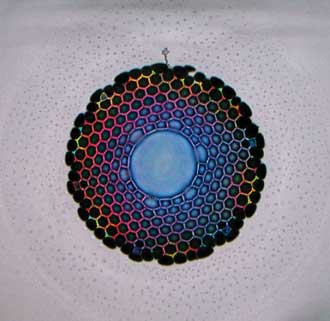
Figure 1. A hollow-core photonic bandgap fiber shows visible light transmitted over a short section: Blue light transmitted in the core and multiple wavelengths transmitted in the microstructured cladding give it a ‘rainbow’ effect.
“Existing telecom systems are edging ever closer to the intrinsic capacity limits of standard fiber,” said Marco N. Petrovich, principal research fellow at the Optoelectronics Research Centre at the University of Southampton in England. “Soon, we may not be able to cope with future data traffic demand. Radical fiber solutions are being investigated to address the limitations of traditional fibers. Since all other ‘dimensions’ have already been exploited, the only one left is space. Novel fibers may outperform current fibers enough to eventually justify replacing them.”
Spatial multiplexing is attracting attention in the telecom community for its promise to increase system capacity without increasing cost and energy consumption. SDM requires new types of microstructured optical fiber (MOF) such as multimode (MMF) or multicore (MCF) to transmit information simultaneously down the same fiber using various spatial modes or multiple cores.1
“These spatial channels can be physically separated or overlapping,” Petrovich said, “so that each channel is carrying as much information as a conventional SMF, or perhaps even more.” As a result, SDM enables significantly higher transmission rates.

Figure 2. (a) Multicore fiber in cross section has several solid cores or rings of cores, typically single mode, around a central solid core within a common cladding. (b) Microstructured/photonic crystal fiber consists of periodic air holes around a solid core. (c) A photonic bandgap-guided hollow-core fiber features a core of air typically larger in diameter than the low-index regions of the photonic crystal cladding formed through periodic air holes.
Typical SMF has an 8.5-µm-diameter single core with a refractive index 0.5 percent larger than the outer cladding, which serves to trap and transmit light down the fiber. A multimode fiber has a much larger central core with an approximately 1.5 percent larger refractive index that guides light in several optical modes, each of which can act as a separate information channel; the optical modes spatially overlap, and suitable processing techniques are required to extract the information carried by each. A multicore fiber, on the other hand, contains several different cores within its cross section, each physically separated.2 Another novel type, hollow-core photonic crystal fiber, guides light in a low-index air core, often hollow, which engenders low optical nonlinearity and low losses (Figure 2).3
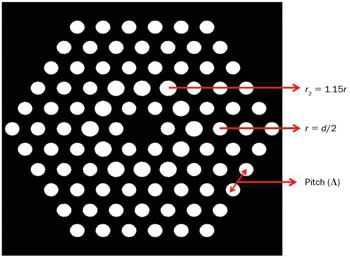
Figure 3. Cross-sectional view of a highly nonlinear chalcogenide
holey fiber designed by Professor Bishnu Pal’s group at IIT Delhi in India for use as an IR light source between 4 and 5 µm.
Cladding consists of five rings of airholes (white circles) embedded in
an arsenic-sulfide (As2S3)-based matrix. The radius of the airholes in the second cladding ring is r2, whereas the center-to-center airhole separation is denoted as pitch (Λ).
Multicore and multimode fibers are similar in that they are both solid fibers like SMF, albeit with different transverse structures (Figure 3). Transmission capacity depends on the number of cores or modes in the fiber. As with SMF, the optical properties of MOFs are correlated to basic geometry: core size, number of rings (or cores), hole diameter (d), hole spacing or pitch (Λ) and the ratio d/Λ.4 Issues that can degrade the performance of SDM systems designed with novel microstructured optical fiber include fiber dispersion, random birefringence and nonlinearity. Linear coupling of one multicore fiber to another is a challenge. One of the most difficult technical aspects of SDM in optical fibers is crosstalk management.
‘Holey’ versatility
Researchers are intently pursuing the development of such a vast number of fiber types optimizing time, wavelength, polarization and spatial multiplexing that it is premature to try to identify a winner in the race. Each addresses a challenge but leaves another challenge. A survey of several recent promising developments helps demonstrate the complex state of new fiber research.
Currently, researchers are investigating the use of MOFs in a long list of applications: erbium-doped fiber amplifiers, nonlinear pulse reshaping and saturable absorption, dense wavelength division multiplexed transmission, distributed feedback lasers, high-power fiber lasers, plasmonic sensors and background-free Raman sensing, among other things (Figure 4). But before SDM becomes practical, several issues specific to MMFs and MCFs must be studied; e.g., co-propagating modes in such fibers can interact both linearly and nonlinearly. Linear coupling in MCFs is of special concern because it leads to a periodic transfer of optical power from one core to neighboring cores. In principle, linear coupling among modes can be efficiently compensated using digital signal processing at the receiver with a multiple-input multiple-output (MIMO) technique. One question that remains is how linear coupling in MCFs affects the nonlinear penalty.
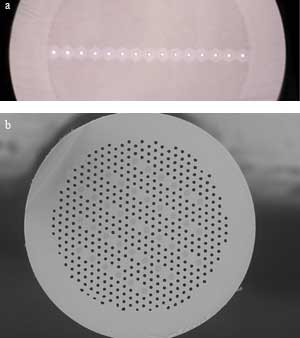
Figure 4. (a) Pursuing a method for short-pulse fiber transmission and shaping, Alain Barthélémy and colleagues at Institut XLIM in collaboration with IRCICA in France split femtosecond pulses into 12 bands via 12 cores of a 15-core Yb-doped fiber.5 (b) The French team also transmitted 190-fs pulses at 1030 nm through five cores of a 19-core microstructured fiber. The dark-gray holes are boron-doped rods.6
In a recent paper, professor Govind Agrawal and colleagues at the University of Rochester Institute of Optics in New York and at Alcatel-Lucent Bell Laboratories in Holmdel, N.J., studied the impact of linear coupling on the nonlinear effects in MCF.7 Their model showed that many intermodal nonlinear terms often can be neglected in practice. Further numerical simulations on MCFs with up to four cores, transmitting 80-Gb/s signals, demonstrated that linear coupling can mitigate the nonlinear impairments to some extent using MIMO techniques to compensate for all the linear effects. Although rapidly varying birefringence effects were not considered, results indicate that the cores of MCFs can be much closer than is currently believed.
In 2012, staff researcher Benjamin G. Lee at IBM T.J. Watson Research Center in Yorktown Heights, N.Y., and colleagues demonstrated a full multicore fiber optic link that transmitted more than 100 Gb/s through a single strand of multimode fiber for the first time.8 They used custom-designed transmitters and receivers interfaced with a seven-core multimode MCF fiber. The fiber transmitted up to 120 Gb/s over 100 m using 2-D arrays of verticalcavity surface-emitting lasers (VCSELs) and vertically illuminated photodiodes (PDs), fabricated at Emcore in Albuquerque, N.M., to couple with the outer six cores of the seven-core fiber (Figure 5). Bit-error-rate (BER) measurements showed negligible degradation of signal resulting from electrical and optical crosstalk, as Agrawal and his Rochester team predicted.
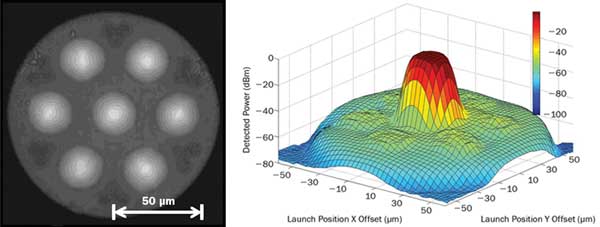
Figure 5. (a) A multimode, multicore glass optical fiber made from seven graded-index fiber core rods arranged in a hexagonal array (top) achieved a record 120-Gb/s transmission. The fiber features core diameters manufactured at 26 µm instead of the usual 50 µm to maintain a standard outer-cladding diameter of 125 µm. The core is doped with germanium oxide. The 50-µm arrow in the image is for scale. (b) The detected power of a 100-m sample of MCF shows negligible core-to-core optical crosstalk in the single-mode-fiber launch location relative to the center of the facet.
Hollow-core photonic bandgap fiber (HC-PBGF) is another type of MOF with a “holey”-looking core, but with important differences compared with multicore and multimode fibers. At the core of these fibers is a lattice of expanded airholes, like a honeycomb, around an oversized core of air. In this fiber, the core has a lower refractive index compared with the cladding, and it guides light via a photonic bandgap effect, whereas conventional solid fiber operates via total internal reflection. HC-PBGF has three advantages over solid fibers: 1000 times lower nonlinearity, potential for lower loss and the ultimate low latency – light travels approximately 33 percent faster in these fibers, very close to the speed of light in vacuum.9 The much lower nonlinearity, in addition to low transmission loss, enables much higher transmission capacity per fiber. And because HC-PBGFs are multimode fibers, several modes could be used as ultrahigh-capacity data transmission channels (Figure 6).10
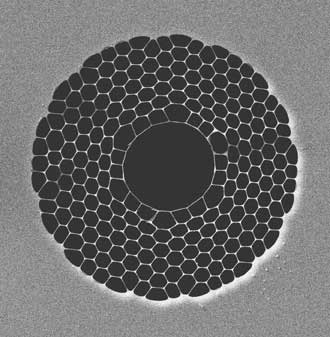
Figure 6. This scanning electron microscope (SEM) image of an HC-PBGF highlights the complex structure composed of a web of very thin (~200 nm thick) struts of silica glass.
“The most exciting area of our work at Southampton is hollow-core fibers,” Petrovich said. “But in the race to find the fiber solution for the next-generation optical fiber networks, it remains to be seen whether multicore, multimode or hollow-core fibers will pull ahead.”
Acknowledgment
The author would like to thank Professor Bishnu Pal at the Indian Institute of Technology in Delhi for his help in the preparation of this article.
References
1. D. Richardson et al (May 2013). Space-division multiplexing in optical fibres. Nat Photon, Vol. 7, p. 354.
2. B.P. Pal (2010). Frontiers in Guided Wave Optics and Optoelectronics. Intech Publishers, Vienna, pp. 1-28.
3. http://www.rp-photonics.com/photonic_crystal_fibers.html.
4. A. Barh et al (2013). Design of an efficient mid-IR light source using chalcogenide holey fibers: a numerical study. J Opt, Vol. 15, p.035205.
5. P. Rigaud et al (in review). Spatially dispersive amplification in a 12-core fiber and femtosecond pulse synthesis by coherent spectral combining. Opt Expr.
6. T. Mansuryan et al (2012). Spatially dispersive scheme for transmission and synthesis of femtosecond pulses through a multicore fiber. Opt Expr, Vol. 20, Issue 22, p. 24769.
7. S. Mumtaz et al (2012). Reduction of nonlinear penalties due to linear coupling in multicore optical fibers. IEEE Phot Tech Lett, Vol. 24, Issue 18, p. 1574.
8. B. Lee et al (2012). End-to-end multicore multimode fiber optic link operating up to 120 Gb/s. J Lightwave Tech, Vol. 30, Issue 6, p. 886.
9. Poletti et al (2013). Towards high-capacity fibre-optic communications at the speed of light in vacuum. Nat Phot, Vol. 7, p. 279.
10. Y. Jung et al (March 2013). First demonstration of a broadband 37-cell hollow core photonic bandgap fiber and its application to high capacity mode division multiplexing. OFC 2013, Anaheim. PDP5A.3